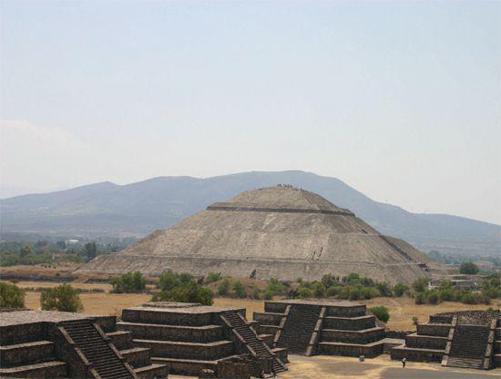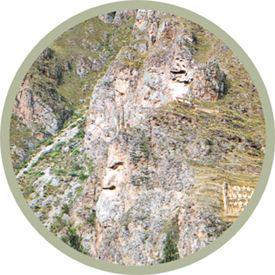The Ancient Alien Question (24 page)
Read The Ancient Alien Question Online
Authors: Philip Coppens

As at Ollantaytambo, the true miracle of the Coricancha is its massive granite blocks. A major earthquake on May 21, 1950,
caused severe localized damage in Cuzco. The buildings from the colonial era were affected, but the city’s Inca architecture withstood the earthquake. Many of the old Inca walls were at first thought to have been lost after the earthquake, but what truly happened was that the earthquake merely exposed the original granite retaining walls of the Coricancha. The superiority of these stones is on display in the streets around the Coricancha. Here, the lower levels of the stones are monolithic and with complex angles, engineered so as to withstand earthquakes. On top are smaller stones. Archaeologists here imitate the work of their colleagues in Baalbek: They obscure the extraordinary difference between the layers, pretending somehow that both layers were the work of the Inca civilization. It is clear that the walls around the Coricancha are evidence of two distinct building techniques, the foundations showing that whoever built them possessed advanced engineering knowledge of working with stone, which was clearly lost by the time the upper layer was built.

When the Spanish Conquistadors discovered the Coricancha, the Temple of the Sun, in the heart of the Inca capital of Cuzco, they stripped all of its walls of their gold. Little remains of the temple, but what does reveals the extraordinary workmanship that went into it, including this doorway.
All of these massive building projects were carried out for one reason: This was the path walked by Viracocha. Modern research has looked at the legend of Viracocha and the Sacred Valley of the Vilcamayu and Urubamba rivers and has concluded that the Sacred Valley symbolized the Milky Way. The Milky Way was the Path of Souls. Cuzco is situated between the two rivers, and on a stellar map of the Milky Way this corresponds with the “dark gate” north of Sagittarius, which was seen as an entry to the Otherworld: a navel indeed!
These radical interpretations that are being put forward will no doubt require time before being accepted by each and all. Still, they sit within a worldwide phenomenon of creator beings walking the land and sculpting it as they go.
It will take even longer before their influence and novel approach is adapted and adopted by archaeologists. Meanwhile, several tourists continue to walk the Sacred Path of Viracocha: Many travel from Tiahuanaco to Cuzco, onward to Ollantaytambo, and finally make the arduous trek to Macchu Picchu. The path is a natural way of moving about the country and has been walked for hundreds of generations, from the earliest farmers to the Inca kings—but it is said that it was first walked by Viracocha.
Fewer tourists, however, visit Tiahuanaco, which author Igor Witkowski has described as “the city that breaks all the rules.” It does. Its most famous feature is a tremendous stone construction known as the Gate of the Sun, with a central image of Viracocha carved into it, showing how this city sits firmly within the bailiwick of the Sacred Valley. It is here that Viracocha is said to have landed on planet Earth.
Officially, the origins of Tiahuanaco date back to 1500
BC
, but its heyday is normally placed in the first centuries
AD
. It was built in an area that was virtually infertile, and therefore the Tiahuanacos created farming platforms. They first placed large rocks on the land to form a base, and then a layer of clay to waterproof it. Then they added a layer of gravel, sand, and soil to create farmable land. Then a series of irrigation ditches were created and filled with water so that agriculture could provide for the local people. The extent of the work involved to make this area inhabitable suggests that there was a very good reason for people to go to so much trouble. Otherwise why didn’t these people simply live somewhere else, where life was easier? The answer to that question was Viracocha.
THE ANCIENT ALIEN QUESTION

The Mitchell-Hedges Crystal Skull is the most enigmatic of all crystal skulls. Its detachable jaw, made from the same piece of crystal as the rest of the skull, has posed an impossible challenge for those looking for a simple explanation.

Ever since Macchu Picchu was discovered in 1911, its beauty and majesty has made it one of the must-visit places on the planet. Though the stones used in its construction are perhaps not as massive as those used in others such sites in Peru, its location makes it part of a sacred pattern that involved the wanderings of the civilizing deity Viracocha.
Skull and Macchu Pichu images courtesy of author.
Background image. Credit: NASA, ESA, M.J. Jee and H. Ford (Johns Hopkins University)

The Zoser Pyramid is the oldest pyramid in Egypt. The entire complex, both in layout and inscriptions, reveals the true purpose of the pyramids. They speak of a festival in which the Pharaoh was to become one with the gods, so that his power and character as a ruler were proven in the eyes of his subjects.

Just slightly smaller than the Great Pyramid, the Pyramid of Khafre has retained some of its covering stones at the top. It therefore allows one to imagine how brilliant these pyramids must have looked in the sunlight during their heyday.

The three pyramids at Giza, just outside of the Egyptian capital of Cairo, are the ancient world’s most enduring legacy. Their size and majesty can only be appreciated in person. They were laid out in the form of Orion’s Belt, conforming to the layout of the Hopi Mesas in Arizona, as well as the pyramid complex in Teotihuacán, Mexico.

The Pyramid of the Sun in Teotihuacán has many things in common with the Great Pyramid of Egypt. Together with the Pyramid of the Moon and the Temple of Quetzalcoatl, it forms the layout of Orion’s Belt, which the pyramids at Giza also mirror. How were these cultures, separated by time and space, able to build their monuments according to the same template?
Images courtesy of author

A detail of the hill that overlooks the temple complex of Ollantaytambo. A section of the hill clearly reveals a face, which has been linked with the god Viracocha, the civilizing deity of the Inca. Judging from the extraordinary engineering that went into some of the ancient structures found in Peru, the divine origins of their builders’ techniques should not be dismissed.
